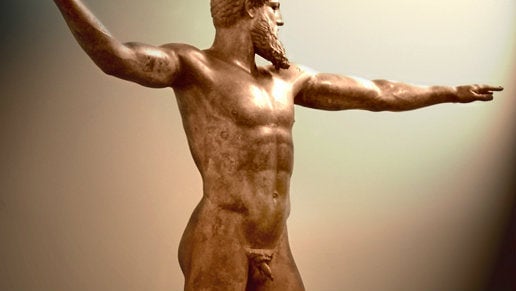Why do Greek statues have such small penises?
Don’t pretend your eyes don’t hover, at least for a moment, over the delicately sculpted penises on classical nude statues. While it may not sound like the most erudite subject, art historians haven’t completely ignored ancient Greek genitalia either. After all, sculptors put as much work into penises as the rest of their artwork, and it turns out there’s a well-developed ideology behind those rather small penises.


Don’t pretend your eyes don’t hover, at least for a moment, over the delicately sculpted penises on classical nude statues. While it may not sound like the most erudite subject, art historians haven’t completely ignored ancient Greek genitalia either. After all, sculptors put as much work into penises as the rest of their artwork, and it turns out there’s a well-developed ideology behind those rather small penises.
In ancient Greece, it seems, a small penis was the sought-after look for the alpha male.
“Greeks associated small and non-erect penises with moderation, which was one of the key virtues that formed their view of ideal masculinity,” explains classics professor Andrew Lear, who has taught at Harvard, Columbia and NYU and runs tours focused on gay history. “There is the contrast between the small, non-erect penises of ideal men (heroes, gods, nude athletes etc) and the over-size, erect penises of Satyrs (mythic half-goat-men, who are drunkards and wildly lustful) and various non-ideal men. Decrepit, elderly men, for instance, often have large penises.”

Similar ideas are reflected in ancient Greek literature, says Lear. For example, in Aristophanes’ Clouds a large penis is listed alongside a “pallid complexion,” a “narrow chest,” and “great lewdness” as one of the characteristics of un-athletic and dishonorable Athenian youths.
Only grotesque, foolish men who were ruled by lust and sexual urges had large penises in ancient Greece. Art history blogger Ellen Oredsson notes on her site that statues of the era emphasized balance and idealism.
“The ideal Greek man was rational, intellectual and authoritative,” she wrote. “He may still have had a lot of sex, but this was unrelated to his penis size, and his small penis allowed him to remain coolly logical.”
There are several theories as to why the “ideal” penis size developed from small in ancient Greece to large today. Lear suggests that perhaps the rise of porn, or an ideological push to subject men to the same body shaming that women typically face, are behind the modern emphasis on having a large penis.
But Lear adds that in both societies, ideas about penis size are completely “unrelated to reality or aesthetics.” Contrary to popular myth, there’s no clear evidence that a large penis correlates with sexual satisfaction. Nor is there proof that a small penis is a sign of moderation and rationality.
“Greek men saw each other nude all the time in the gymnasium, so they must have been aware, at some level, that not every admirably moderate man had a small penis, and not every immoderate, cowardly, drunken man a large one,” adds Lear.
Society has been transformed in the thousands of years since ancient Greece but, when it comes to penis size, we’ve simply swapped one groundless theory for another.